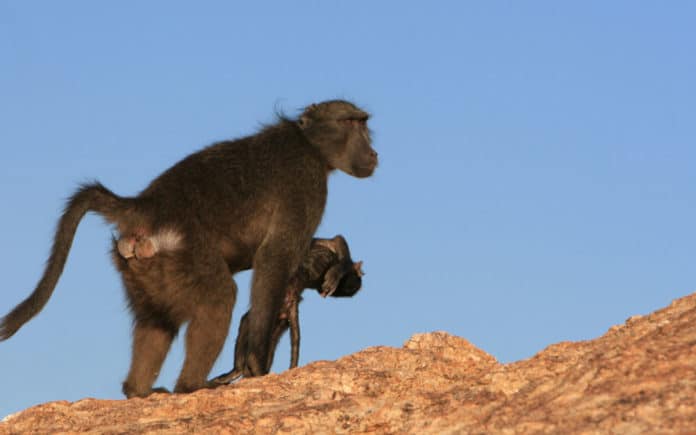What do animals know of death? What can animals’ responses to death tell us about the evolution of species’ minds, and the origins of humans’ awareness of death and dying?
A new study may provide beginnings of answers to these questions. Scientists reported 12 cases of group members’ responses to infants’ deaths, including one miscarriage and two stillbirths, recorded over 13 years in wild Namibian chacma baboons.
Scientists found that wild baboons’ responses to dead infants were similar to other primates: Baboon mothers living in the wild carry dead infants for up to ten days. During this time, the mother grooms the dead infant frequently.
Chacma baboons live in large multi-sex groups, with strong linear male and female hierarchies. One group of baboons can range anywhere from 20 to 100 primates.
Lead author, Dr. Alecia Carter (UCL Anthropology and Université de Montpellier), said: “There are numerous hypotheses to explain primate responses to dead infants. Perhaps the most reliable hypothesis is that carrying after death is an extension of nurturing behavior.“
“We are not suggesting that the mothers are unaware that their infants are dead, but there is such strong selection on mother-infant bond formation that, once formed, the bond is difficult to break. It’s less clear why only some mothers carry or protect their dead infant, but I suspect that a range of factors influences this behavior.“
According to the grief-management hypothesis, mothers carry the dead infant as a way of dealing emotionally with their loss. On the other hand, the ‘social-bonds hypothesis’ which suggests that mothers give their infants because of the intense social bond mothers and infants share during life.
Another possible explanation is that the mother acks the cognitive ability to discriminate between ‘dead’ and ‘unresponsive but alive,’ and that continued care is ultimately an adaptive behavior in case the unresponsive individuals recover.
According to scientists, various factors influence the length of time a mother carries her dead infant, including the mothers’ age, infant cause of death, and the climate conditions.
Scientists also observed father baboons and found that the fathers of the infant—protect the dead infant, either by threatening observers that came close or, on one occasion, sitting near and grooming the dead infant when the mother moved away temporarily.
The last author on the study, Dr. Elise Huchard (Université de Montpellier), said: “This is quite surprising behaviour because previous studies have rarely reported it. Male baboons are not usually very paternal, but they regularly protect their infant from threats, especially from infanticidal attacks. That is where a male baboon kills another male’s offspring to mate with the mother.”
Dr. Carter adds: “Other primates have been observed carrying their dead infants for much longer periods. Chimps and Japanese macaques, for example, have been observed carrying infants for over a month. However, chacma baboons travel much longer distances on an average day, and the desert environment is harsh, making it costly for a mother to carry her infant for long periods.”
The research is published in the Royal Society Open Science.
